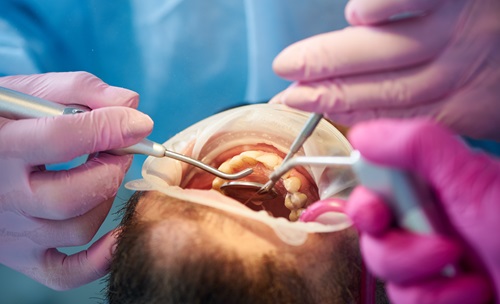Root Canal
- Home
- Services
- Oral Surgery
- Root Canal
Root Canal Treatment involves the removal of the infected pulp and the sealing of the tooth to prevent further bacterial entry and the recurrence of infection. Cavities, damaged teeth, and facial trauma can create pathways for bacteria to invade a tooth’s pulp, leading to an infection. In such cases, a root canal procedure becomes necessary to salvage the affected tooth.
Overview
What is a root canal procedure?
A root canal is a dental procedure designed to address infections, inflammation, or damage to a tooth’s pulp—the soft inner tissue—commonly referred to as an abscessed tooth. The pulp comprises nerves, blood vessels, and connective tissue. In cases where the pulp becomes infected, individuals may experience severe pain, sensitivity to hot and cold temperatures, swelling, and the potential formation of an abscess. The root canal procedure involves the removal of the infected pulp to alleviate these symptoms and preserve the tooth.
How common are root canal procedures?
Root canals are routine dental procedures, and despite their historical association with pain, modern dental techniques and effective anesthetics have considerably enhanced patient experience. The advancement in dental practices has minimized discomfort, making root canals a more tolerable and manageable procedure.
What does a root canal procedure do?
Root canals are frequently recommended to maintain a tooth’s functionality and appearance instead of extraction. Losing a tooth can result in difficulty chewing, shifting surrounding teeth, and potential bone loss in the jaw. Our dental team prioritizes the preservation of your natural teeth whenever possible, aiming to sustain both the function and aesthetics of your smile.
A root canal procedure is necessary when the pulp of a tooth becomes infected, inflamed, or damaged. The most common reason for this to happen is when a cavity is left untreated, but this can occur due to various reasons, including:
Benefits & Risks
Benefits of a root canal procedure
Opting for root canal therapy offers several advantages, including the ability to:
- Stop the spread of infection to neighbouring teeth.
- Alleviate symptoms linked to an abscessed tooth.
- Minimize the likelihood of jawbone damage.
- Avoid tooth extraction.
- Avoid damage to your jawbone which could require a bone grafting procedure to repair.
Are root canal procedures safe?
Modern root canal treatments are widely regarded as safe, boasting a high success rate of approximately 98%. However, it’s important to note that a root canal is not typically recommended for women in their first or third trimester of pregnancy. Nevertheless, during the second trimester, some dentists may consider performing the procedure with the use of only a local anesthetic, prioritizing the safety and well-being of both the mother and the developing baby.
What happens if a root canal fails?
Failed root canals are rare, but if it does happen, your dentist may perform another root canal as soon as possible or discuss alternative treatment options.
Symptoms of a failed root canal procedure?
In isolated cases, root canal complications can occur. This is usually only when a tooth is too damaged for a root canal procedure to be effective. The symptoms of a failed root canal include:
- Pain that doesn’t go away
- Draining pus from the affected area
- Visible pimple or boil
- Tooth discolouration
- Swollen gums
- Sinus problems
Root canal treatment, also known as endodontic therapy, is a dental procedure performed to treat infection or damage within the pulp of a tooth. The pulp is the soft tissue inside the tooth that contains nerves, blood vessels, and connective tissue. When the pulp becomes infected or inflamed due to decay, trauma, or other factors, it can cause severe pain and eventually lead to abscess formation and tooth loss if left untreated. During a root canal procedure, the dentist or endodontist removes the infected or damaged pulp, cleans and disinfects the inside of the tooth, and then fills and seals it with a biocompatible material, typically gutta-percha.
This helps to save the natural tooth and alleviate pain while preventing further infection or damage. Root canal treatment is often considered the last resort before tooth extraction and can help restore function and aesthetics to the affected tooth.

